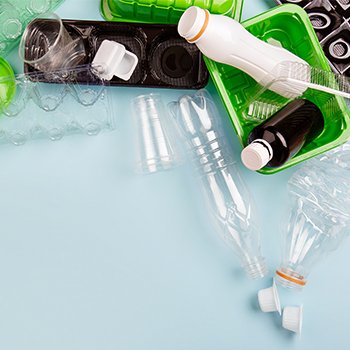ความท้าทายและโอกาสของการนำพลาสติกรีไซเคิลมาใช้เป็นวัสดุสัมผัสอาหาร Challenges and Opportunities in Using Recycled Plastics as Food Contact Materials
306 Views |

ความท้าทายและโอกาสของการนำพลาสติกรีไซเคิลมาใช้เป็นวัสดุสัมผัสอาหาร
Challenges and Opportunities in Using Recycled Plastics as Food Contact Materials
By: ดร. สาธุกานต์ กาบคำ
Sathukarn Kabcum, Ph.D.
Thai Packaging Centre
Thailand Institute of Scientific and Technological Research
sathukarn@tistr.or.th
ดร. นพรัตน์ วิริยะกิจพัฒนา
Nopparat Viriyakitpattana, Ph.D.
Thai Packaging Centre
Thailand Institute of Scientific and Technological Research
nopparat_v@tistr.or.th
กระบวนการรีไซเคิลพลาสติกเพื่อใช้เป็นวัสดุสัมผัสอาหาร
ถ้าหากพิจารณาปริมาณของพลาสติกชนิดอื่นที่มีอยู่ในท้องตลาด พลาสติกชนิดพอลิเอทิลีนชนิดความหนาแน่นสูง (HDPE) ก็มีปริมาณการใช้ที่เพิ่มมากขึ้นเช่นกัน โดยพลาสติกชนิด HDPE เป็นเทอร์โมพลาสติกซึ่งเป็นพลาสติกในกลุ่มพอลิโอเลฟิน (พอลิเอทิลีนและพอลิพรอพิลีน) มีความแข็งและเหนียว ยืดหยุ่นต่อแรงกระแทก ทนทานต่อสารเคมีและตัวทำละลายหลายชนิด สามารถขึ้นรูปเพื่อนำมาใช้ประโยชน์ในงานต่างๆ เช่น บรรจุภัณฑ์อาหาร ขวดแชมพู และของเล่น อีกทั้งยังสามารถนำกลับมาหลอมเพื่อขึ้นรูปใช้ใหม่ได้ ดังนั้นพลาสติกชนิด HDPE จึงกลายเป็นที่น่าสนใจในการนำมารีไซเคิลเพื่อใช้เป็นวัสดุสัมผัสอาหาร ซึ่งในกระบวนการรีไซเคิลพลาสติกโดยทั่วไปจะเป็นกระบวนการแปรรูปขยะพลาสติกให้อยู่ในรูปแบบที่นำไปใช้งานต่อได้ โดยสามารถแบ่งเป็น 3 ประเภทหลัก ดังนี้
1. การรีไซเคิลแบบปฐมภูมิ (Primary recycling) เป็นการนำเศษพลาสติก (Scrap) ที่เป็นประเภทเดียวกัน ไม่มีสิ่งปนเปื้อนและไม่เคยบรรจุสัมผัสอาหาร ซึ่งเป็นเศษเหลือจากกระบวนการผลิตหรือขึ้นรูปแล้วนำกลับมาหมุนเวียนใช้ซ้ำภายในโรงงาน โดยพลาสติกที่ได้นี้เรียกว่า พลาสติกจากกระบวนการผลิต (Post-industrial recycled plastic; PIR plastic)
2. การรีไซเคิลแบบทุติยภูมิ (Secondary recycling) หรือการรีไซเคิลด้วยวิธีทางกล (Mechanical recycling) เป็นการแปรรูปพลาสติก โดยการเก็บพลาสติกที่ผ่านการใช้งานแล้วมาคัดแยกตามประเภท จากนั้นนำมาบด ล้าง ทำความสะอาด หลอม และขึ้นรูปใหม่ เพื่อนำกลับไปใช้เป็นผลิตภัณฑ์พลาสติกอีกครั้ง สามารถนำมาผสมกับเม็ดพลาสติกใหม่เพื่อให้ได้สมบัติตามที่ต้องการ ซึ่งการรีไซเคิลด้วยเทคนิคนี้ เป็นเทคนิคที่ง่ายและนิยมใช้มากที่สุดในปัจจุบัน โดยกระบวนการรีไซเคิลแบบทุติยภูมินี้จะไม่ทำให้ธรรมชาติของพอลิเมอร์เปลี่ยนไป
3. การรีไซเคิลแบบตติยภูมิ (Tertiary recycling) หรือการรีไซเคิลด้วยวิธีทางเคมี (Chemical recycling) เป็นการแปรรูปพลาสติกให้กลับไปอยู่ในรูปสารตั้งต้น โดยทำให้โครงสร้างสายโซ่ของพอลิเมอร์เกิดการขาดหรือแตกออก (Depolymerization) จนได้มอนอเมอร์ (Monomer) หรือโอลิโกเมอร์ (Oligomer) เมื่อนำมาทำให้บริสุทธิ์โดยการกลั่นและตกผลึกจะได้เป็นสารตั้งต้นที่มีคุณภาพสูง โดยนำมาผ่านกระบวนการพอลิเมอไรเซชันอีกครั้งเพื่อที่จะผลิตเป็นพอลิเมอร์ใหม่ได้
Recycling Processes for Plastic as Food Contact Materials
Among the other plastics available on the market, the usage of high-density polyethylene (HDPE) has also increased. HDPE is a thermoplastic in the polyolefin group (comprising polyethylene and polypropylene) known for its hardness, toughness, flexibility, and resistance to chemicals and solvents. It is used in food packaging, shampoo bottles, and toys and can be remelted for reuse, making HDPE an attractive option for recycling as a food contact material. Plastic recycling generally transforms plastic waste into reusable forms and can be classified into three main types:
1. Primary Recycling involves recycling plastic scraps of the same type, free from contaminants that have not come into contact with food. These scraps, which come from manufacturing or molding processes, are reused within the factory. This type of recycled plastic is called post-industrial recycled (PIR) plastic.
2. Secondary Recycling, also known as mechanical recycling, involves collecting post-consumer plastic, sorting it by type, then grinding, washing, melting, and remolding it into new plastic products. This technique is simple and widely used, with the polymer properties remaining unchanged.
3. Tertiary Recycling, also known as chemical recycling, breaks down polymer chains through depolymerization, returning them to their monomer or oligomer forms. These monomers are then purified through distillation and crystallization, producing high-quality feedstock that can be repolymerized into new polymers.





